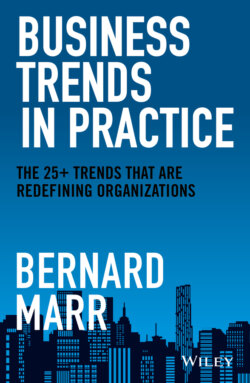Читать книгу Business Trends in Practice - Бернард Марр, Bernard Marr - Страница 23
Trend 2: Connected and Smart Everything
ОглавлениеYou'll no doubt be familiar with the Internet of Things (IoT) from devices like smart TVs, smart watches, and smart thermostats. The IoT refers to the increasing number of intelligent devices and objects that are connected to the internet and are capable of gathering and transmitting data. The IoT is now growing at such a rate that we have intelligent, well, everything. It's hard to pinpoint the exact number of connected devices on the planet, but some estimates suggest that by 2030 as many as 50 billion IoT devices will be installed worldwide.4 That's more than 6 times the number of people on the planet.
And by intelligent everything, I mean everything. Yoga mats, lightbulbs, cars, robots, drones, ships — these and many more are becoming “smart,” meaning they're capable of connecting to the internet, gathering data on what's going on around them, communicating that data with other devices or platforms, and often making decisions or taking action based on the data. Looking ahead, it's clear that anything that can be connected, will be. One cool example comes from the US Navy's Sea Hunter autonomous unmanned surface vehicle prototype (basically, an autonomous drone ship). Sea Hunter has already sailed autonomously from California to Hawaii and back without the need for a crew, and is being integrated into a naval carrier strike group,5 meaning sailors will have to get used to operating alongside unmanned ships.
And this notion of smart everything doesn't just relate to devices and products (although that is obviously a key consideration for businesses); it also relates to intelligent spaces. From smart, connected factories and offices to entire smart cities, the spaces around us are increasingly being equipped with the ability to monitor what's going on and act accordingly. For example, public transportation routes can be adjusted in real time according to demand, or traffic flows can be monitored and analyzed to improve congestion. Alibaba's City Brain system uses AI to optimize a city's infrastructure, and in the Chinese city of Hangzhou, it has helped reduce traffic jams by 15 percent.6
Of course, this pervasive connectivity brings with it increased security risks. Connecting anything to the internet makes it vulnerable to cyberattack, which makes securing connected devices and spaces all the more important.
This ability to connect things and places to the internet (and to each other) has the potential to transform many industries, including manufacturing, education, healthcare, and defense. Perhaps most importantly for many businesses, this notion of connected everything provides a unique insight into how customers (and employees for that matter) really behave, versus how they say they behave. Manufacturers of connected cars, for instance, can understand when, where, and how their customers drive. This sort of knowledge is profoundly useful to businesses in terms of understanding how customers use products, designing future products, increasing customer satisfaction, and more. This is why data can be considered one of the most important assets modern businesses have at their disposal. And that brings us to the next topic.
